Open interface III
This revision is from 2017/01/10 13:06. You can Restore it.
Interface device between computer and transceiver - accesses all controls, CAT and audio to PC.
Quick Start Guide
- Make wiring connect to your TRX
- Preset board jumpers
- Connect power supply (if not powered from TRX)
- Preset firmware CAT and upload
Main function
- Completly Open source
- Hardware and software is open (cc by-sa)
- You can modify or build own software functionality
- Arduino compatible chip (ATMEGA2560)
- Operation system independent (Linux, OSX, Windows)
- CW - complete K3NG code
- CLI interface (telnet) or Winkey emulation
- Memory button
- Speed rotary encoder
- Keying from PC com port (DTR/RTS)
- SSB
- Switch TX audio between Microphone (Foot switch PTT) and USB Audio (com PTT)
- Playing audio memory from PC
- FSK (RTTY)
- from three source
- Serial com port (DTR/RTS) - EXTFSK
- Serial com port ASCII (telnet)
- Three button memories
- Sidetone
- Decoding TX signal during transmit from EXTFSK
- DIGI Modes
- Adjust TX volume buttons
- Adjust RX volume potentiometer
- Isolated audio path with two transformers
- CAT
- Support TTL (Icom) and 232 level (Kenwood, Yaesu)
- Own serial to USB interface with internal USB HUB
- Band decoder
- Support Icom, Kenwood, Yaesu CAT
- Sniffing TRX to PC communications or automatically own request
- Outputs
- TTL level BCD
- CAT on ACC connector - CI-V, Kenwood/Yaesu (need TTL/232 converter)
- IP output (in future)
- OTHER
- Galvanically isolated USB to PC - four independent ground
- PC
- Transceiver
- RX audio
- TX audio
- micro SD card slot for future use (save config)
- Ethernet module
- two type PA PTT output
- Relay - isolated but 5ms latency
- Open collector - quick
- ACC connector (HDMI type) with
- Serial line
- I2C
- PWM
- Analog inputs
- Digital in/out
The hardware
Front side

- 1 - PTT LED - shows the activation of one of the PTT outputs (PTT1, PTT2, PTT-SSB, PA-PTT)
- 2 - CW LED - shows the activation of one of two CW outputs (CW1, CW-232)
- 3 - FSK LED - shows the activation of one of two FSK outputs (FSK-Arduino, FSK-232)
- 4 - Rotary encoder - change WPM speed in CWK and CWD MODE, and select MENU in other mode
- 5 - SET/MEM 0 button - has functions depending on the selected MODE
- in CWD and CWK MODE activate/deactivate Command mode
- in FSK MODE activate transmit Memory-0
- 6 - MEM 1-2 button - in CWD CWK FSK MODE activate two memories
- 7 - MODE button
- Short press MODE changes in the order |CWK >CWD |SSB >FSK |FSK |DIG
- Long press activate MENU on LCD. In the menu, move with the rotary encoder or short press MODE button. Return change after 3 seconds without change
- 8 - LCD display
- First line show
- transmiting CW character
- transmiting RTTY character from Arduino uppercase
- transmiting RTTY character from PC lowercase
- Second line show
- First eleven characters - selected MENU
- Second four characters - active MODE or numbers MENU
- Last characters - show microSD card icon, if pluged
- 9 - TX audio + button - volume UP
- 10 - TX audio - button - volume DOWN
- 11 - TX audio mute button - MUTE
- 12 - RX volume potentiometer - receiving signal level
Rear side
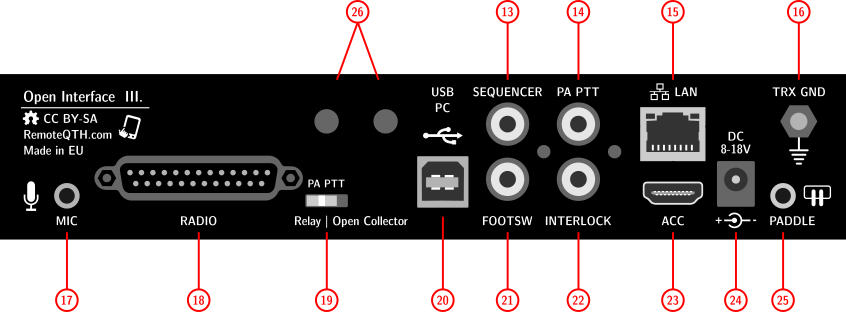
- 13 - SEQUENCER output CINCH - open collector (MAX 50V/500mA)
- 14 - PA-PTT output CINCH - dependency to rear PA PTT switch
- Open collector (MAX 50V/500mA)
- Relay (MAX 0,5A/125V AC, or 1A/24V DC)
- 15 - LAN - RJ45 connector - (if Ethernet optional module installed)
- 16 - TRX GND - M4 screw
- 17 - MIC - Jack 3,5mm - microphone input - need preset input switch, dependency on type microphone used
- Dynamic microphone - JP7 open
- Electret microphone - JP7 short
- 18 - RADIO - D-SUB 25 pin female connector Pin connection
- 19 - PA PTT - manual switch - select what circuit will be switch PA-PTT output (CINCH and pin7 in RADIO connector)
- Open collector (MAX 50V/500mA)
- Relay (MAX 0,5A/125V AC, or 1A/24V DC)
- 20 - PC USB - USB B type connector for PC, with isolated ground
- 21 - FOOT SWITCH - CINCH - SSB PTT input is activated by grounding center pin
- 22 - INTERLOCK - CINCH - input is activated by grounding center pin
- 23 - ACC - HDMI type - by default blinded Read warning first!
- 24 - POWER - input - DC jack 2,1/5,5mm diameter to connect input power 8-18V DC (center positive)
- 25 - PADDLE - input - Pinout
Left side
- microSD card slot
- RESET button
Block diagram
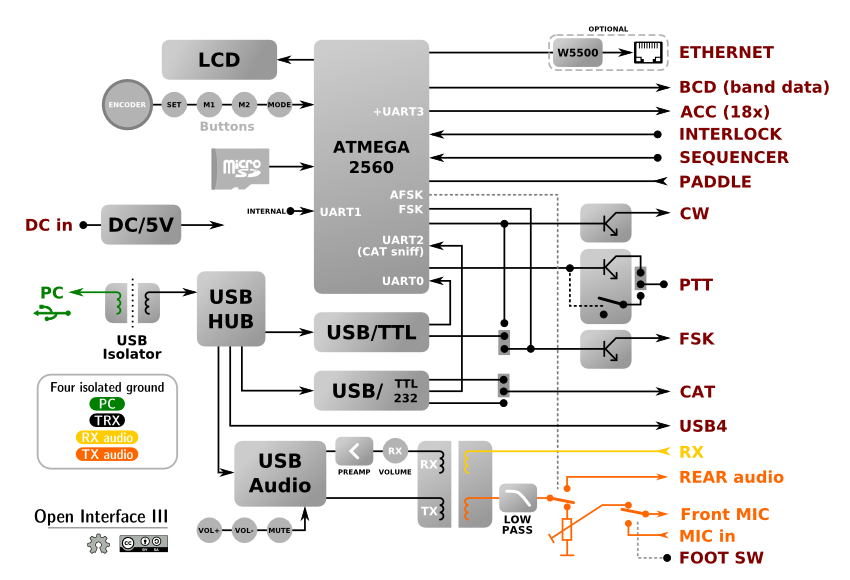
Board jumper preset
- JP4 - DTR to CW/FSK - select DTR output from USB/serial interface to activate keying CW or FSK output
- JP3 - Auto reset ON - enabling reset from serial DTR pin to Arduino
- SHORT - enable - need only for upload firmware
- OPEN - disable - standard operation
- JP5 - Self reset ON - allows Arduino self reset from D39 output (not use)
- by default OPEN
- JP10 - CAT Icom/Other - select between Icom CI-V and other TRX bus
- Icom - left
- Other TRX - right
- JP7 - DC to MIC - allows DC voltage from TRX to your microphone
- OPEN for dynamic microphone
- SHORT for elecret microphone
- P5 - CAT TTL/232 - select between two logical level
- 5V TTL - ICOM
- +-12V RS232
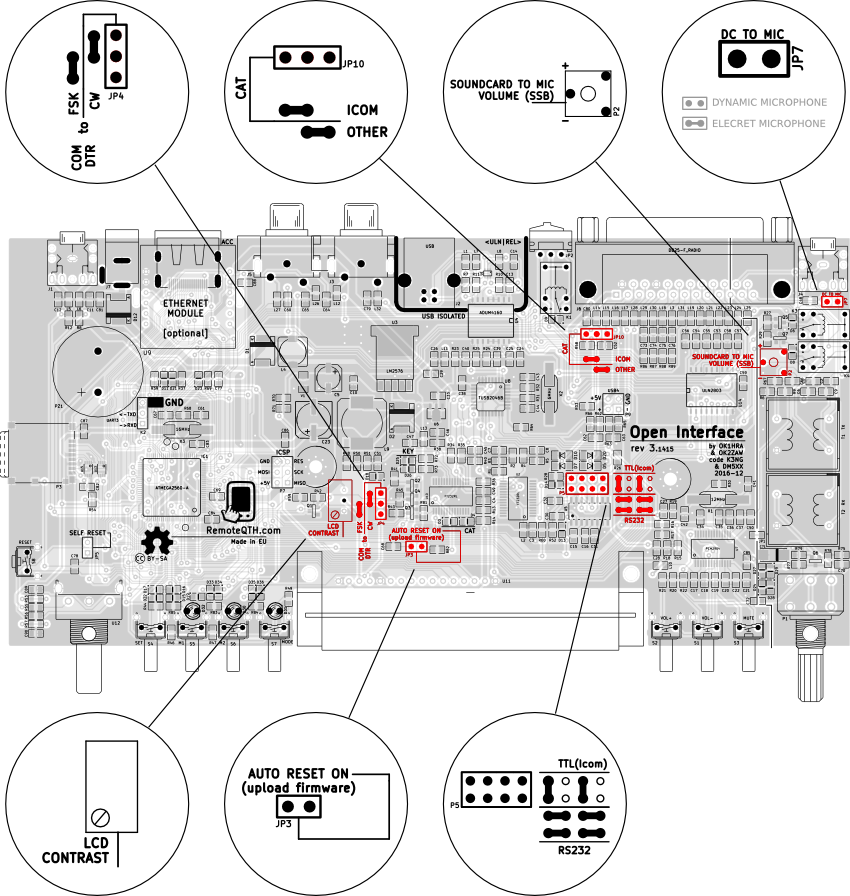
Board adjust
- P4 - LCD contrast potentiometer
- P2 - TX USB souncard to front Microphone volume potentiometer adjust transmit audio volume if activate MODE SSB. Suitable for playing voice memory.
Internal connectors
- K2 - ATmega Serial3 UART (5V) RXD, TXD, GND
- P7 - ICSP connector for directly programing ATmega chip - need for upload bootloader contains GND RESET MOSI SCK +5V MISO
- P9 - free USB4 output from USB hub - same signal available on rear DB-25 connector
Not staffed parts
- R6 package 0805 - activate voltage divider with R9, can reduce audio signal output level
- C71 package C - will increase RX audio preamp gain
- C50 package 0805 - activate Left channel output (TX) from USB sound card
Hardware dependency
| Mode | Source | Outs | ||
| PTT | CW/FSK | WINKEY | AFSK | |
| CWK - CW keyer | PTT1 | CW1/2 | HIGH | LOW |
| >CWD - CW daemon (PC) | RTS | DTR* | LOW | LOW |
| SSB - LSB-USB-FM | RTS/FootSW | - | LOW | LOW |
| >FSK - EXTFSK | RTS | DTR* | LOW | LOW |
| FSK - Serial ascii | PTT1 | Serial | HIGH | LOW |
| DIG - USB audio codec (AFSK) | RTS | - | LOW | HIGH |
* JP4 jumper must be set CW or FSK
Note - character ">" shown external signal source
- WINKEY HIGH - disable DTR/RTS
- AFSK HIGH - switch TX audio path
Problems
- Disconnecting the USB causes high potential (measured 80V AC) between USB-GND and GND-TRX, is usually enough:
- Grounded case
- Replace the power supply (not the male switched adapter without grounding pin in the drawer)
Firmware
This manual describes the function of the modified firmware from K3NG, which in addition includes:
- Switch MODE - preset board for each mode separately
- MENU - show many actual value and firmware preset
- Band decoder - sniffing CAT or generate own request for read frequency, with BCD (IP in future) output
- FSK keying - RTTY keying from memory button or serial line
- FSK decode - RTTY decode signal generate from PC (EXTFSK)
How to upload
- Open enclosure (remove screws on lef, right and rearside)
- Short JP3 jumper
- Upload
- Open JP3 jumper
- Close enclosure
LCD
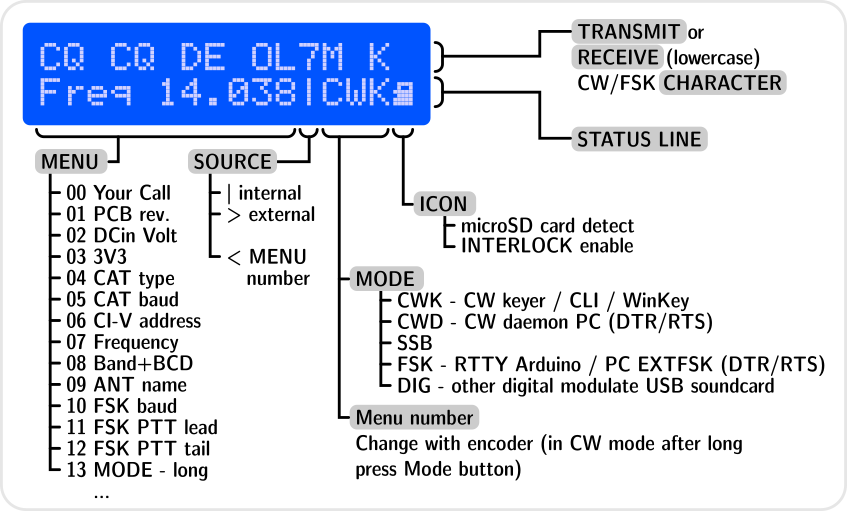
- First line show
- TX signal in CW and FSK mode
- RX sniffing decode RTTY (lowercase) during keying from PC
- Second status line show
- MENU
- Source keying
- MODE
- microSD card icon, if insert
Modes
- |CWK - CW Keyer by K3NG
- WinKey/CLI emulation
- SOURCE: USB/Serial interface
- INPUTS: Paddle Interlock Encoder Set/Mem_buttons
- OUTPUTS: CW1/2 PTT1/2
- >CWD - CW Daemon
- Keyng from PC
- SOURCE: USB/Serial interface DTR/RTS
- INPUTS: DTR(CW) RTS(PTT)
- OUTPUTS: CW1 PTT1
- |SSB - SSB
- LSB USB AM FM
- SOURCE: Mic-audio
- INPUTS: FootSwitch RTS
- OUTPUTS: PTT1
- >FSK - PC FSK keying
- RTTY keying from EXTFSK with sniffing and decode signal (lowercase) by JI3BNB / OK1HRA
- SOURCE: USB/Serial interface, Memory0-2_button
- INPUTS: DTR RTS
- OUTPUTS: PTT1 FSK
- |FSK generator by JI3BNB
- generator from Serial ASCII
- SOURCE: USB/Serial interface
- INPUTS: ASCII, Memory0-2_button
- OUTPUTS: PTT1 FSK
- |DIG - Audio FSK
- AFSK PSK and any modes modulate fom audio
- SOURCE: USB souncard
- INPUTS: RTS(PTT)
- OUTPUTS: PTT
Wiring
- Icom IC-746
- Kenwood TS-480
- Elecraft K3
Pinouts
RADIO 25 pin D-SUB

| pin-1 | in | Input power 8-18V DC from Transceiver |
| pin-2 | out | CAT TXD / CI-V |
| pin-3 | out | USB4 +5V output |
| pin-4 | - | USB4 -Data |
| pin-5 | out | BCD4 output TTL |
| pin-6 | out | BCD2 output TTL |
| pin-7 | out | PA PTT |
| pin-8 | out | PTT1 |
| pin-9 | out | CW1 |
| pin-10 | out | FSK |
| pin-11 | out | Microphone (TX) |
| pin-12 | out | TX audio |
| pin-13 | out | RX audio |
| pin-14 | - | Transceiver GND |
| pin-15 | in | CAT RXD |
| pin-16 | - | USB4 +Data |
| pin-17 | - | TRX GND |
| pin-18 | out | BCD3 output TTL |
| pin-19 | out | BCD1 output TTL |
| pin-20 | out | PTT2 |
| pin-21 | out | CW2 |
| pin-22 | out | PTT Microphone |
| pin-23 | in | Interlock |
| pin-24 | - | TX audio GND |
| pin-25 | - | RX audio GND |
| shield | - | Transceiver GND |
Microphone

- 3,5 mm Jack - need preset internal jumper dependency to type your microphone
- JP7 - DC to MIC - allows DC voltage from TRX to your microphone
- OPEN for dynamic microphone
- SHORT for elecret microphone
Paddle

- 3,5 mm Jack - activate grounding input
- Settings Dot / Dash side available from
- Firmware
- Command mode after press SET button
Accessory connector (HDMI)
By default covered by break-out panel, because outputs are not protected.
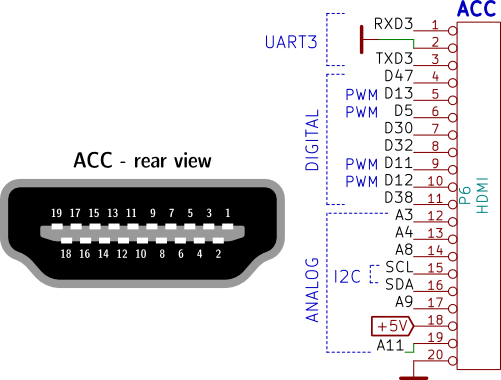
WARNING! - All ACC signals directly connect to ATMEGA chip without some ESD protection. Before use strongly recomended protect this lines. Otherwise, you can damage ATmega chip.
| ACC-1 | RXD | Serial3 |
| ACC-2 | GND | |
| ACC-3 | TXD | Serial3 |
| ACC-4 | D47 | |
| ACC-5 | D13 | PWM |
| ACC-6 | D5 | PWM |
| ACC-7 | D30 | |
| ACC-8 | D32 | |
| ACC-9 | D11 | PWM |
| ACC-10 | D12 | PWM |
| ACC-11 | D38 | |
| ACC-12 | A2 | |
| ACC-13 | A3 | |
| ACC-14 | A8 | |
| ACC-15 | SCL | I2C |
| ACC-16 | SDA | I2C |
| ACC-17 | A9 | |
| ACC-18 | +5V | |
| ACC-19 | A11 | |
| ACC-20 | GND |
ATMEGA-2560 pinout (rev 3.1415)
| Arduino pins | connect to | in/out | Note |
| RX0 | USB | in | Connect to USB/serial interface |
| TX0 | USB | out | use for command CW keyer or firmware upload |
| D2 | Interlock | in | pull-up external, Interrupt 0 |
| D3 | PTT-232 | in | pull-up external, Interrupt 1 |
| D4 | CW tone | out | |
| D5 | ACC pin6 | PWM | |
| D6 | LCD-D4 | out | |
| D7 | LCD-D5 | out | |
| D8 | LCD-D6 | out | |
| D9 | LCD-D7 | out | |
| D10 | Ethernet SCS | out | |
| D11 | ACC pin9 | PWM | |
| D12 | ACC pin10 | PWM | |
| D13 | ACC pin5 | PWM | |
| TX3 | ACC pin3 | out | + Internal pins |
| RX3 | ACC pin1 | in | + Internal pins |
| TX2 | CAT | out | Connected in parallel to USB/serial CAT interface |
| RX2 | CAT | in | use for CAT sniffing or TX request |
| D18 | Encoder-B | in | pull-up internal (optional external*), Interrupt 5 (TX1) |
| D19 | PTT foot | in | pull-up external, Interrupt 4 (RX1) |
| D20 | SDA - ACC pin16 | in/out | I2C, Interrupt 3 |
| D21 | SCL - ACC pin15 | out | I2C, Interrupt 2 |
| D22 | PTT2 | out | |
| D23 | FSK | out | keying from arduino |
| D24 | Encoder-A | in | pull-up internal (optional external*) |
| D25 | PTT3 | out | |
| D26 | paddle Left | in | pull-up external |
| D27 | WinKey | out | HIGH if CW keying running (disable DTR/RTS) |
| D28 | paddle Right | in | pull-up external |
| D29 | AFSK | out | HIGH if AFSK keying (switch TX audio path) |
| D30 | ACC pin7 | ||
| D31 | PTT-PA | out | |
| D32 | ACC pin8 | ||
| D33 | FSK detector | in | pull-up external |
| D34 | CW1 | out | |
| D35 | CW2 | out | |
| D36 | MENU | in | pull-up external |
| D37 | LCD-E | out | |
| D38 | ACC pin11 | ||
| D39 | self reset | out | HIGH (enable with jumper JP5) |
| D40 | Sequencer | out | |
| D41 | PTT1 | out | |
| D42 | BCD1 | out | TTL Band data |
| D43 | BCD2 | out | TTL Band data |
| D44 | BCD3 | out | TTL Band data |
| D45 | BCD4 | out | TTL Band data |
| D46 | Ethernet detect | in | pull-up internal |
| D47 | ACC pin4 | ||
| D48 | Internal SMT pad | Free | |
| D49 | Internal SMT pad | Free | |
| D50 | MISO | out | |
| D51 | MOSI | out | |
| D52 | SCK | out | |
| D53 | microSD CS | out | |
| A0 | Internal SMT pad | Free | |
| A1 | CW keyer Memory button | in | pull-up external |
| A2 | LCD-RS | out | |
| A3 | ACC pin12 | ||
| A4 | ACC pin13 | ||
| A5 | microSD plug | in | pull-up internal |
| A6 | measure 3.3V | in | |
| A7 | measure input voltage | in | coefficient 11 |
| A8 | ACC pin14 | ||
| A9 | ACC pin17 | ||
| A10 | - | Free | |
| A11 | ACC pin19 | ||
| A12 | - | Free | |
| A13 | - | Free | |
| A14 | - | Free | |
| A15 | - | Free |
- If RC circuits installed